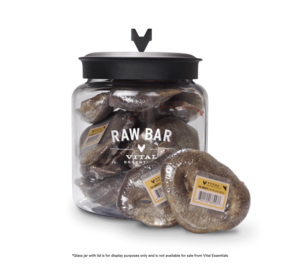Vital Essentials Raw Bar Pig Snouts Review
PawDiet has been helping pet owners since 2015. To fund our efforts, articles may include affiliate links; if you buy something through a link, we may earn a commission.
Review of Vital Essentials Raw Bar Pig Snouts
According to our most recent data, this product is intended for intermittent or supplemental feeding only.
Review of Ingredients
In our review of Vital Essentials Raw Bar Pig Snouts, we'll examine all 1 ingredients and highlight the nutritional contribution of each ingredient.
While the first few ingredients typically dominate the recipe's composition, ingredients in small quantities can still have a meaningful impact on the overall nutritional profile of the recipe.
Pork snout is a novel protein source that is often well tolerated by dogs with food sensitivities. It's also a good source of essential amino acids for muscle development and overall health.
Review of Guaranteed Analysis
The guaranteed analysis of Vital Essentials Raw Bar Pig Snouts indicates that the product is very high in protein, with a minimum crude protein content of 71.00%. The primary and only ingredient in this product is pig snout, which is a meat-based ingredient. Meat is a rich source of protein, which explains the high protein content in this pet food. The pig snout, being composed largely of muscle and connective tissues, contributes significantly to the overall protein percentage.
The crude fat content is at a minimum of 13.00%. Again, the sole ingredient, pig snout, is responsible for this fat content. Animal tissues naturally contain fats, which are essential for a balanced diet in pets, providing energy and supporting cell function. The fat in pig snouts would come from both the subcutaneous fat that may be attached to the snout and the intramuscular fat within the tissues.
Lastly, the product has a maximum crude fiber content of 5.00%. While muscle meats like pig snout are not typically high in fiber, there may be some connective tissues or cartilage attached to the snouts that contribute to this fiber content. However, since meat is generally low in fiber, the 5.00% crude fiber might also be attributed to the hair or undigestible parts of the snout, which are not broken down by the pet's digestive system. This fiber content is relatively low, as expected in a meat-centric pet product.

